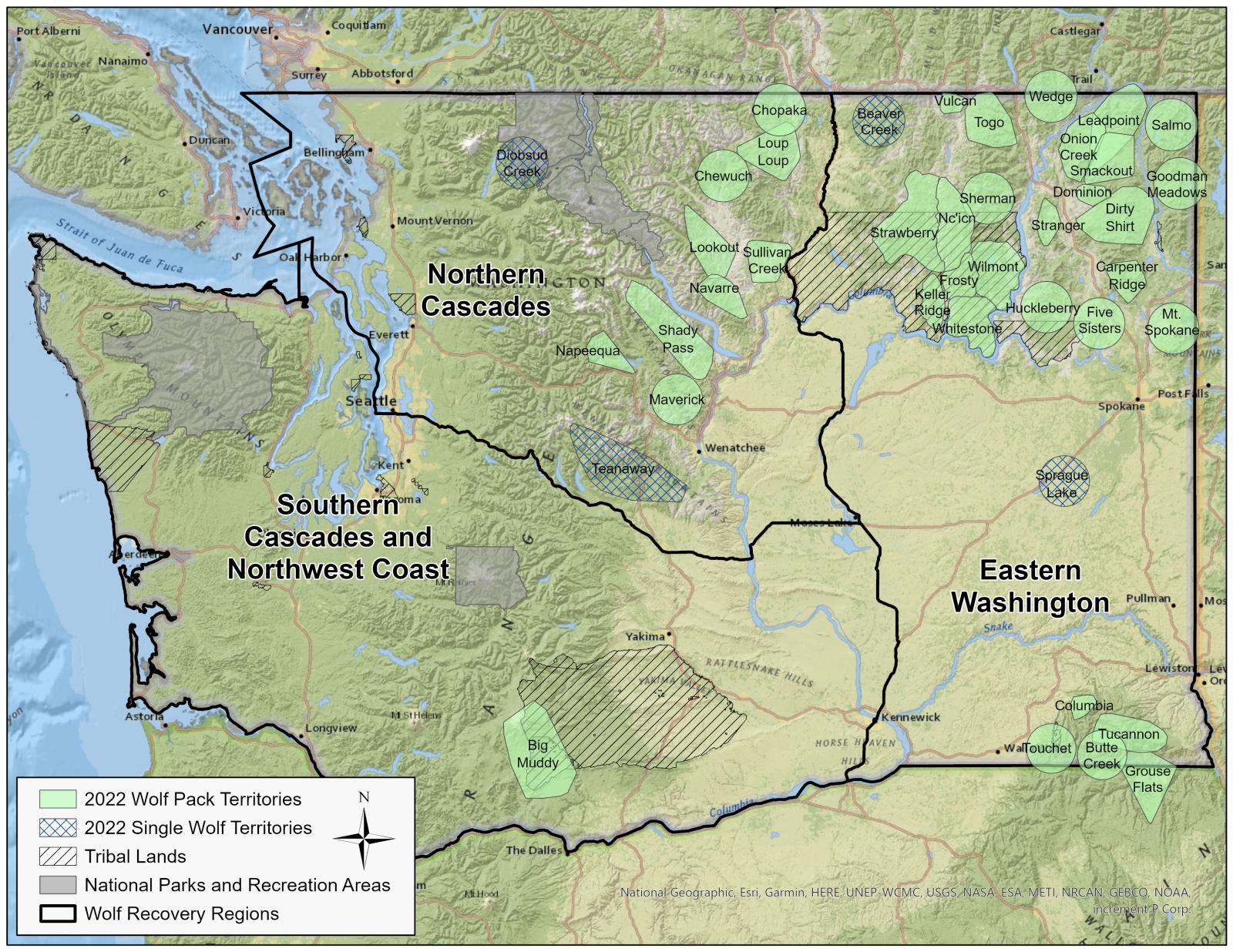ARCHIVED NEWS RELEASE
This document is provided for archival purposes only. Archived documents
do not reflect current WDFW regulations or policy and may contain factual
inaccuracies.
News release April 7, 2023
Julia Smith, (360) 790-1029
Staci Lehman, Communications, (509) 710-4511
OLYMPIA – Washington’s wolf population continued to grow in 2022 for the 14th consecutive year.
The Washington Gray Wolf Conservation and Management 2022 Annual Report was released today by the Washington Department of Fish and Wildlife (WDFW) and shows a 5% increase in wolf population growth from the previous count in 2021. WDFW also documented Washington’s first pack to recolonize the south Cascades this winter.
“The growth we're observing in the North Cascades continues to be encouraging and having a pack become established in the South Cascades is a big step toward recovery of wolves in Washington," said WDFW Director Kelly Susewind. "The goal has been for wolves to spread into all three recovery zones, and we are pleased to see their progress in recolonizing their former range."
As of Dec. 31, 2022, WDFW and Tribes counted 216 wolves in 37 packs in Washington. Twenty-six of these packs were successful breeding pairs. These numbers compare with the previous year’s count of 206 wolves in 33 packs and 19 breeding pairs.
Eight new packs formed in 2022 including the Big Muddy pack in Klickitat County, the Napeequa and Maverick packs in Chelan County, the Chopaka and Chewuch packs in Okanogan County, the Wilmont pack on the Confederated Tribes of the Colville Reservation (CTCR) in Ferry County, the Five Sisters pack in Stevens County, and the Mt. Spokane pack in Spokane County.
Wolves are counted annually through activities like track, aerial, and camera surveys. As in past years, survey results represent minimum counts of wolves in the state due to the difficulty of accounting for every animal – especially lone wolves without a pack.
Because this is a minimum count, the actual number of wolves in Washington is higher. Since the first WDFW survey in 2008, the state’s wolf population has grown by an average of 23% per year.
Most wolf packs were not involved in documented livestock depredation in 2022. Eighty-one percent were not involved in any known or probable livestock depredations, while 19% of known wolf packs were involved in at least one confirmed depredation. Only three packs were involved in two or more depredations. Fifteen cattle and two sheep were confirmed killed by wolves, and one was likely killed by wolves. Also, nine cattle were confirmed as injured and two were likely injured by wolves in 2022 by seven packs.
“Implementation of proactive, nonlethal deterrence efforts by livestock producers, community partners, range riders, and WDFW staff has minimized documented livestock depredation and removal of wolves, all while our wolf population continues to grow,” said WDFW Wolf Policy Lead Julia Smith.
Since 1980, gray wolves have been listed under state law as endangered throughout Washington. In January of 2021, wolves were federally delisted from federal Endangered Species Act protection and WDFW resumed statewide management of the species. On February 10, 2022, wolves were federally relisted in the western two-thirds of the state and U.S. Fish and Wildlife Service (USFWS) once again has the lead role in the recovery of wolves in the North Cascades and the Southern Cascades and Northwest Coast recovery regions.
Contributors to WDFW's annual wolf report include the US Fish and Wildlife Service, the National Park Service, the Spokane Tribe of Indians, Swinomish Tribe, Yakama Nation, and the Confederated Tribes of the Colville Reservation.
The Washington Gray Wolf Conservation and Management 2022 Annual Report is available on the Department’s website at wdfw.wa.gov. A recording of today’s presentation of the report to the Fish and Wildlife Commission will be available on the website soon. Following the conclusion of that report, wolf biologists will be available to speak with journalists. Those who are not able to attend that meeting in person can contact Staci Lehman, Communications Manager, at staci.lehman@dfw.wa.gov or 509-710-4511 by 5:30 p.m. today to arrange a call with a biologist following the presentation.
The Washington Department of Fish and Wildlife works to preserve, protect, and perpetuate fish, wildlife and ecosystems while providing sustainable fish, wildlife, and recreational and commercial opportunities.
